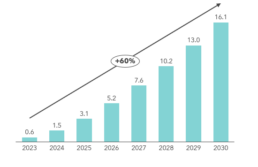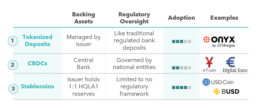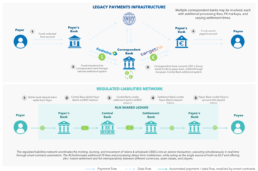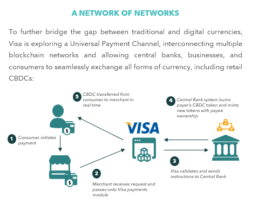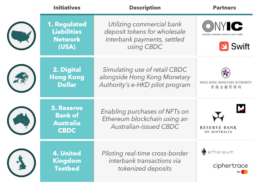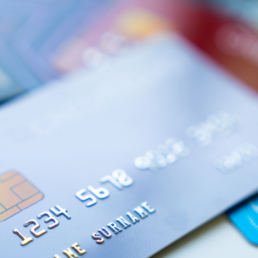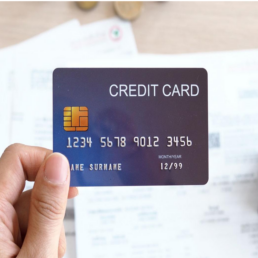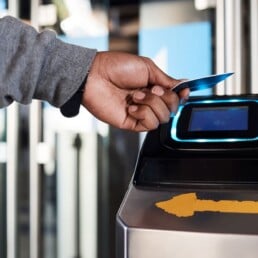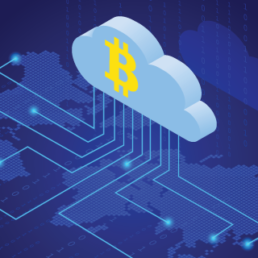Prologue
In June 2023, payments processor Visa released its decentralized finance platform, enabling cross-border payments via Central Bank Digital Currencies (CBDCs). The proof-of-concept, designed in partnership with Microsoft and the Banco Central do Brasil, was Visa’s latest foray into a blockchain-enabled future of payments. Following Visa’s completion of a similar Digital Hong Kong Dollar (e-HKD) pilot program hosted by Hong Kong Monetary Authority just months later, Mastercard unveiled its own CBDC pilot program, developed alongside Mintable and the Reserve Bank of Australia and enabling real-time payments via eAUD on a public blockchain in late 2023.
The Rapid Adoption
The rise of blockchain technology is poised to dramatically transform the global exchange of value and information across industries such as finance, healthcare, and supply chain. Currently valued at US$17.5B, the global blockchain technology market is expected to grow 87.5% year-over-year from 2023 to 2030.(1)
Within financial services, payments accounted for 44% of global blockchain revenue in 2022.(2) Blockchain-enabled payment rails can domestic support domestic and cross-border transactions in near real-time, often with lower fees, faster settlements, and improved security relative to legacy card networks.
As global payments grows to US$748B in 2024(3), legacy card networks are increasingly aware of the impact of blockchain-enabled rails and digital assets.
Exhibit 1. Tokenized Market(4), 2023-30
(in US$ trillions)
Blockchain-enabled digital assets
Most of the market is already aware of the most common form: crypto currencies. This paper, however, focuses more on digital tokenized currencies rather than crypto, being the more speculative sub-class. Some of these notable blockchain-enabled digital assets are:
1. Tokenized Deposits: Traditional bank deposits are represented as digital assets on a blockchain or distributed ledger
2. CBDCs: The digital version of a country’s national currency issued and regulated by the central bank
3. Stablecoins: A type of cryptocurrency, pegged to fiat currency, to minimize price volatility
Together, tokenized deposits, CBDCs, & stablecoins are seeing increased applications across all financial sectors, as investment vehicles, mechanisms for money movement and instant settlement, instruments for executing central monetary policy, as well as data transmission. Unlike past digitization efforts, these tokenized assets are unique for driving transparency in ownership and enabling faster transactability, while facilitating financial inclusion for previously unbanked populations.
Exhibit 2. Digital Assets
What's at Stake?
Traditional forms of payment infrastructure require multiple middlemen, often layered with hidden costs. Cross-border payments involve not only the payer’s bank and the recipient’s bank, but also correspondent banks and payment rails, all reliant on various processing times, currency conversions, and time zone differences. These factors result in an opaque, cumbersome, and expensive process – annually, ~US$120B(5) is spent on systemwide costs for cross-border transactions, excluding FX costs. Settlement times for these transactions often range from 2 to 5 days (see Exhibit 3).
Blockchain technology can not only address these issues, but also introduce greater efficiencies and capabilities across all payments use cases, particularly among those that employ tokenized deposits, CBDCs, and stablecoins.
Exhibit 3. Cross Border Transactions
The Size of the Prize
With blockchain technology, card networks can not only transform consumer payments but also empower B2B transactions and trade finance with faster settlements, cheaper transactions, and additional value-added services. This positions them as a central hub for a more efficient and secure digital financial ecosystem. Exhibit 3 outlines how the described benefits below allow for quicker, cheaper, and more efficient payments in the context of cross-border transactions.
FASTER SETTLEMENT (RETAIL AND COMMERCIAL BANKING APPLICABILITY)
Transactions on a blockchain are validated and recorded in real-time, eliminating intermediary delays and the need for reconciliation. The accelerated settlement aspect has both retail and commercial applicability. In retail scenarios, savings solutions and remittances flows are a prime target. In January 2024, Coinbase announced a partnership with Yellow Card to provide access to the stablecoin USDC and usher in a new era of savings, remittance, and routine commerce solutions across 20 nations in Africa. For commercial banking, faster settlements improve liquidity and working capital management for businesses. B2B International Trade Finance: With blockchain, trade finance documents can be securely verified on a shared ledger, enabling near-instantaneous release of funds upon shipment confirmation, which improves cash flow for both the manufacturer and the retailer.
ELIMINATING MIDDLEMEN
Blockchain facilitates direct B2B transactions, eliminating the need for correspondent banks and reducing associated fees, hence resulting in improved margins.
Interbank Wholesale Payments: With blockchain, the transaction can be settled directly between the two banks on a shared ledger, bypassing correspondent banks and their fees.
ADDITIONAL VALUE-ADDED SERVICES
Existing B2B payment systems lack the flexibility and automation needed for complex transactions. Smart contracts on the blockchain are self-executing agreements that automate specific tasks based on pre-defined conditions. Smart Contracts benefit the card networks by reducing costs and operational errors as they automate complex workflows.
Money Movement: With smart contracts, payments can be automatically triggered which is verified through blockchain-based tracking data. This cuts middlemen, lowers fees, and speeds up cross-border payments.
Some examples of smart contracts in financial services include DAML + SETL for the Regulated Liabilities Network (see Exhibit 4). This combination allows central banks and commercial banks to build a shared network for issuing and trading tokenized liabilities. DAML simplifies writing clear and secure smart contracts for these financial instruments, while SETL ensures fast and efficient settlement.
Exhibit 4. Smart Contracts
What's Next?
As blockchain technologies grow increasingly prevalent in payments, networks should aim to expand their reach beyond the now-outdated multi-currency and bank settlement rails. The intersection of cryptocurrency and traditional currency has opened the doors for a “network of networks”, facilitating traditional fiat and legacy settlement rails to co-exist with 24/7 real-time blockchain networks. Card networks are uniquely positioned to leverage their expansive reach to garner synergetic partnerships with blockchain providers. As card networks explore potential opportunities, we recommend:
1. USE CASE IDENTIFICATION: First map out a landscape of current use cases based on your offerings. This should be segmented by domestic and international reach and augmented with data on different users / stakeholders and business criticality.
2. PAIN POINT DETECTION: Based on these identified use cases, card networks should identify their respective current or foreseeable pain points, with a priority on those related to settlement speed, cost, and efficiency.
3. DIGITAL ASSET & BLOCKCHAIN AS ENABLERS: For identified pain points, card networks should strive to explore the potential for digital assets and other blockchain technology as a solution enabler. What additional investments or resources are needed for an ideal solution construct?
4. POTENTIAL PILOT PROGRAM: Shortlist use cases to pilot proposed digital asset / blockchain solutions, balancing criticality with required investment. Create pilot testbeds, in partnership with technology providers, to test solutions in contained scenarios and measure their derived benefits. Consider actions for expansion of pilot programs.
Several notable pilot programs leveraging CBDCs have already been spearheaded by Visa and Mastercard. Visa, in particular, has taken a blockchain-agnostic approach towards digital assets and blockchain technology, launching a series of expansive partnerships and pilot programs and laying a foundation for its Universal Payment Channel (see Exhibit 5).
Similarly, following its acquisition of Ciphertrace in 2021, Mastercard has since worked directly with US and foreign central banking agencies to pilot its use of wholesale and retail CBDCs and tokenized deposits (see Exhibit 6).
Exhibit 5. A Visa Case Study
Exhibit 6. Mastercard Pilot Programs
Looking Towards the Future...
The future of card networks is centered around decentralized transactability, and blockchain is the key that unlocks it.
Here’s why blockchain isn’t a fad, but an inevitable evolution for the future of payments:
- Blockchain technology is here to disrupt the traditional money movement rails by enabling direct transactions without unnecessary middlemen, leading to a dramatic decrease in processing fees.
- The ability of blockchain to facilitate instant settlements is another major reason why it’s here to stay for card networks. This translates to faster access to funds, reduced operational costs, and improved customer experience.
- The introduction of self-executing automated programs on the blockchain like smart contracts has become a game-changer for card networks; resulting in eradicating all human errors or manual work
- Blockchain’s cryptography and decentralized nature make it incredibly secure. Fraudulent transactions become near-impossible, providing a robust security foundation for the future of payments.
By streamlining the entire transaction process, blockchain empowers the card networks with a faster, cheaper, and more efficient way to handle transactions.
Traditional fiat and legacy settlement rails must begin to grapple with rapidly changing blockchain-enabled technologies.
The future ‘network of networks’ isn’t solely about bank settlement rails and multi-currency functionality, but rather, the addition of stablecoins, tokenized deposits, CBDCs, and other blockchain networks as well as connectivity to other stores of value (e.g., bank accounts, closed-loop wallets, brokerage accounts).
To remain competitive in the evolving financial landscape, card networks are uniquely positioned to bridge this gap between traditional payments and new blockchain networks as transaction facilitators, leveraging their global reach to make transactions on their networks quicker, cheaper, and more secure.
__________________________________________________________________________________________________________
- Grand View Research
- Grand View Research
- Business Research Company
- Boston Consulting Group & ADDX
- J.P. Morgan Onyx
